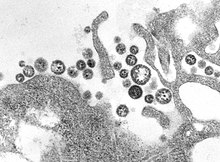Lassa virus
| Lassa Virus (LASV) | |
|---|---|
 |
|
| TEM micrograph of Lassa virus virions. | |
| Virus classification | |
| Group: | Group V ((-)ssRNA) |
| Order: | Unassigned |
| Family: | Arenaviridae |
| Genus: | Arenavirus |
| Species: | Lassa virus |
Lassa virus (LASV) is an arenavirus that causes Lassa hemorrhagic fever, a type of viral hemorrhagic fever (VHF), in humans and other primates. Lassa virus is an emerging virus and a select agent, requiring Biosafety Level 4-equivalent containment. It is endemic in West African countries, especially Sierra Leone, the Republic of Guinea, Nigeria, and Liberia, where the annual incidence of infection is between 300,000 and 500,000 cases, resulting in 5,000 deaths per year.
Recent discoveries within the Mano River region of west Africa have expanded the endemic zone between the two known Lassa endemic regions, indicating that LASV is more widely distributed throughout the tropical wooded savannah ecozone in west Africa. Currently, there are no approved vaccines against Lassa fever for use in humans.
In 1969 missionary nurse Laura Wine fell ill with a mysterious disease she contracted from an obstetrical patient in Lassa, a village in Borno State, Nigeria. She was then transported to Jos, Nigeria where she died. Subsequently, two others became infected, one of whom was fifty-two-year-old nurse Lily Pinneo who had cared for Laura Wine. Samples from Pinneo were sent to Yale University in New Haven where a new virus, that would later be known as Lassa virus, was isolated for the first time. By 1972, the multimammate rat was found to be the main reservoir of the virus in West Africa, able to shed virus in its urine and feces without exhibiting visible symptoms.
Lassa viruses are enveloped, single-stranded, bisegmented, ambisense RNA viruses. Their genome is contained in two RNA segments that code for two proteins each, one in each sense, for a total of four viral proteins. The large segment encodes a small zinc-binding protein (Z) that regulates transcription and replication, and the RNA polymerase (L). The small segment encodes the nucleoprotein (NP) and the surface glycoprotein precursor (GP, also known as the viral spike), which is proteolytically cleaved into the envelope glycoproteins GP1 and GP2 that bind to the alpha-dystroglycan receptor and mediate host cell entry.
...
Wikipedia
